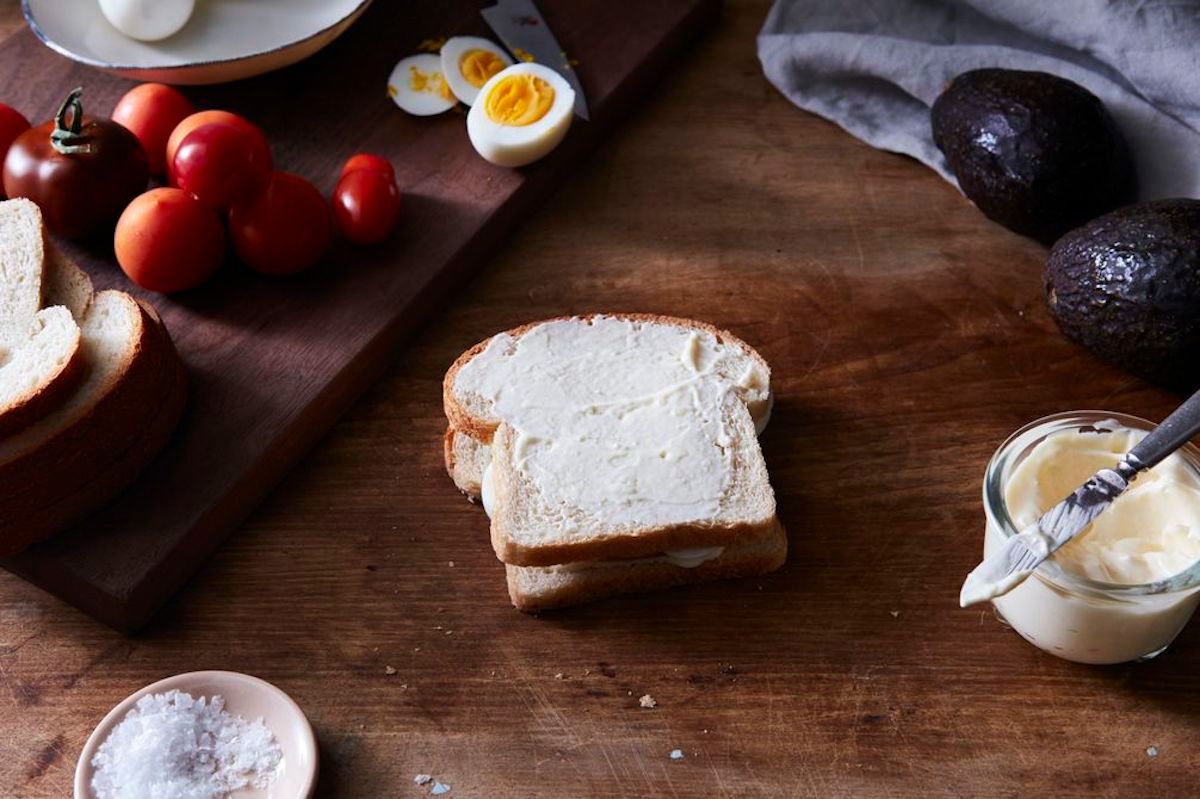Mayonnaise is flavored fat that's been processed in a special way to make it spreadable, even when it's cold. The concept rests on the intuition that fat is good; flavored fat is better; and (in certain situations) creamy, spreadable flavored fat is best of all. Learn how to make mayonnaise in your home kitchen by learning all about it here, and you may never reach for the store-bought jar again.
What Is Mayonnaise?
The process of creating mayonnaise is a sort of culinary magic trick called emulsification. Emulsification is when two liquids that don't mix realize a kind of union with the help of a third ingredient (known as an emulsifier). In the case of mayonnaise, oil and water are held together by emulsifiers found in egg yolk.
An emulsion looks like a homogeneous blend, but it's really not. At a microscopic level, the oil in mayonnaise is still separate from the water, suspended in droplets. The emulsifier is the key element that makes this possible, because it keeps the oil droplets from coalescing into larger globules and separating (like oil and water). Paradoxically, the emulsifier keeps the oil and water together by keeping them apart.
Why is this relevant? Because to learn how to make mayonnaise, it helps to understand how it works, and to visualize what you're doing with your whisk, blender, or other mechanical implement: breaking drops of oil into tiny droplets — which must be kept tiny — so the emulsifier can do its magic.
As with most cooking techniques, understanding the foundation gives you control and creative freedom. Master the basic process, and start making mayonnaise without a recipe, customizing it to your tastes, and creating variations. Then you can extend your abilities to the many mayonnaise derivatives like remoulade, aioli, Russian dressing, blue cheese dressing, green goddess dressing, vegan mayonnaise, and so on.
Tips And Tricks
- Use quality eggs. This one almost goes without saying. The best-quality eggs you can get your hands on are the best ones for making rich, flavorful mayonnaise. If you have any concerns about consuming raw egg, then use pasteurized eggs. You can find pasteurized eggs at any supermarket, or you can pasteurize your own (but honestly it's a bit of a pain and not guaranteed to work). If you really want to geek out on the safety of mayonnaise, read this.
- Use room temperature ingredients. Using cold ingredients will reduce the effectiveness of emulsifiers.
- Use a neutral-flavored oil (unless you want a stronger flavor). Mayonnaise is mostly oil. If you use a mild-flavored oil, like canola or sunflower, you'll be able to taste the other ingredients in the mix. If you use an oil with a strong flavor, like a grassy, peppery extra-virgin olive oil, your mayonnaise might be out of balance if the mayo itself is what you're looking to taste (or if you're looking for a milder overall flavor to use in sweet recipes like mayonnaise cakes).
- Use oils with higher amounts of unsaturated fats. These fats, like canola and avocado oils, are easier for the emulsifier to keep separate.
- Add the oil very, very slowly. Otherwise, the droplets won't disperse. They'll coalesce, and the emulsion will start to break and separate.
- If your emulsion breaks, it's easy to fix. Do this by whisking a small amount of the broken mayo with a little water. When the mixture starts to emulsify, slowly, slowly drizzle in the rest of the broken mayo.
- Use water to make the mayo thinner, and oil to make it thicker. To a point, that is. One egg yolk can emulsify only about 7 ounces of oil. Much more than that, and your emulsion is likely to break.
Basic Mayonnaise Recipe
- 1 egg yolk, room temperature
- 1 1/2 teaspoons fresh-squeezed lemon juice or white wine vinegar
- 1/2 teaspoon mustard (prepared or dry)
- 6 ounces neutral oil
- 1 1/2 teaspoons salt
- In a medium bowl, whisk together the egg yolk, lemon juice or vinegar, and mustard.
- Whisking constantly, add the oil slowly, drop by drop.
- When you see the oil incorporate and thicken, your emulsion has begun. You can add the oil a little faster, as long as you are still able to disperse it quickly.
- When all the oil is incorporated and the mayonnaise is thick and creamy, stir in the salt. Taste, and adjust, if necessary.
- Store in a tightly sealed jar or container in the refrigerator for 3 to 4 days.
Make Your Own Mayonnaise




Shares